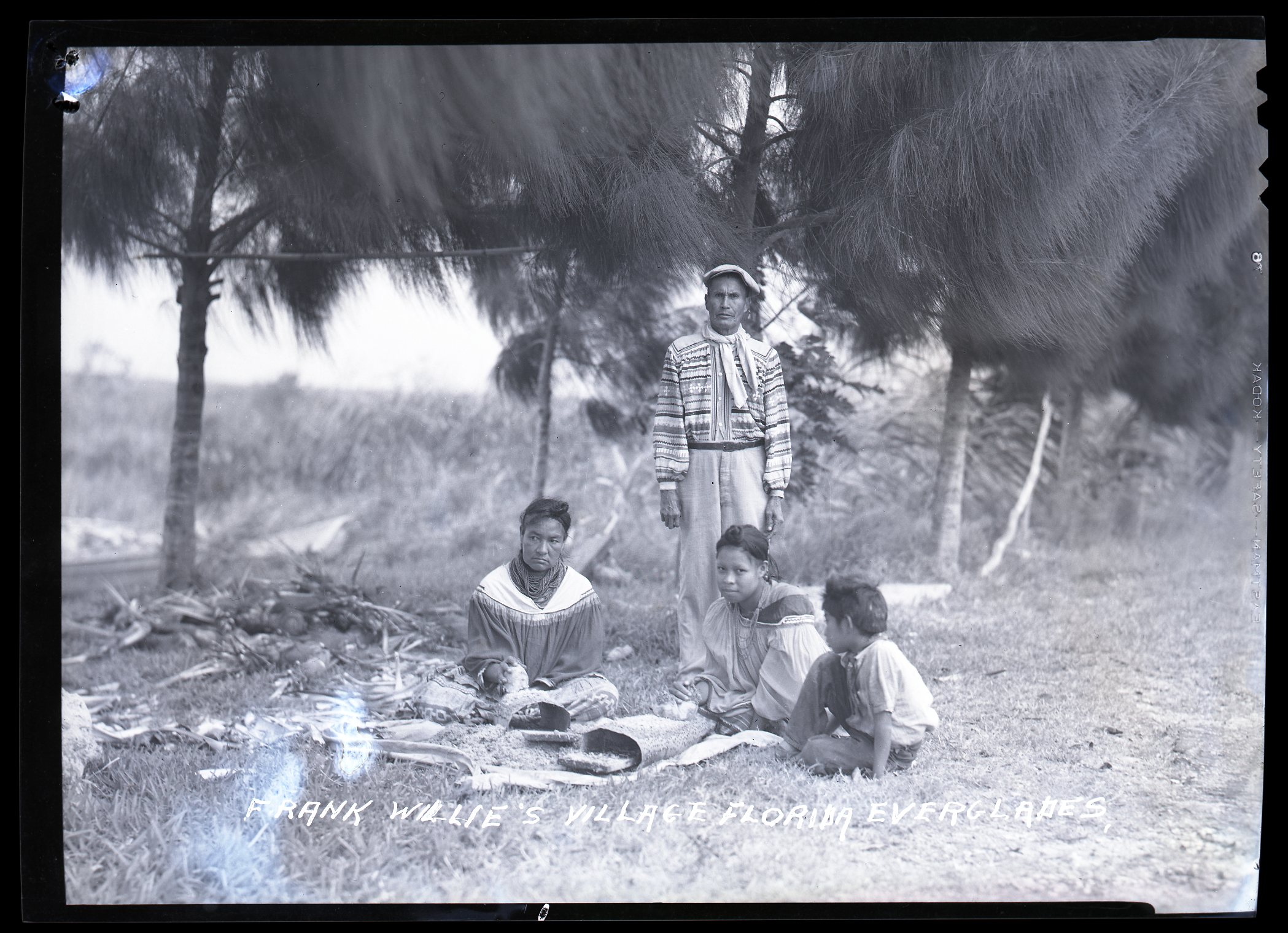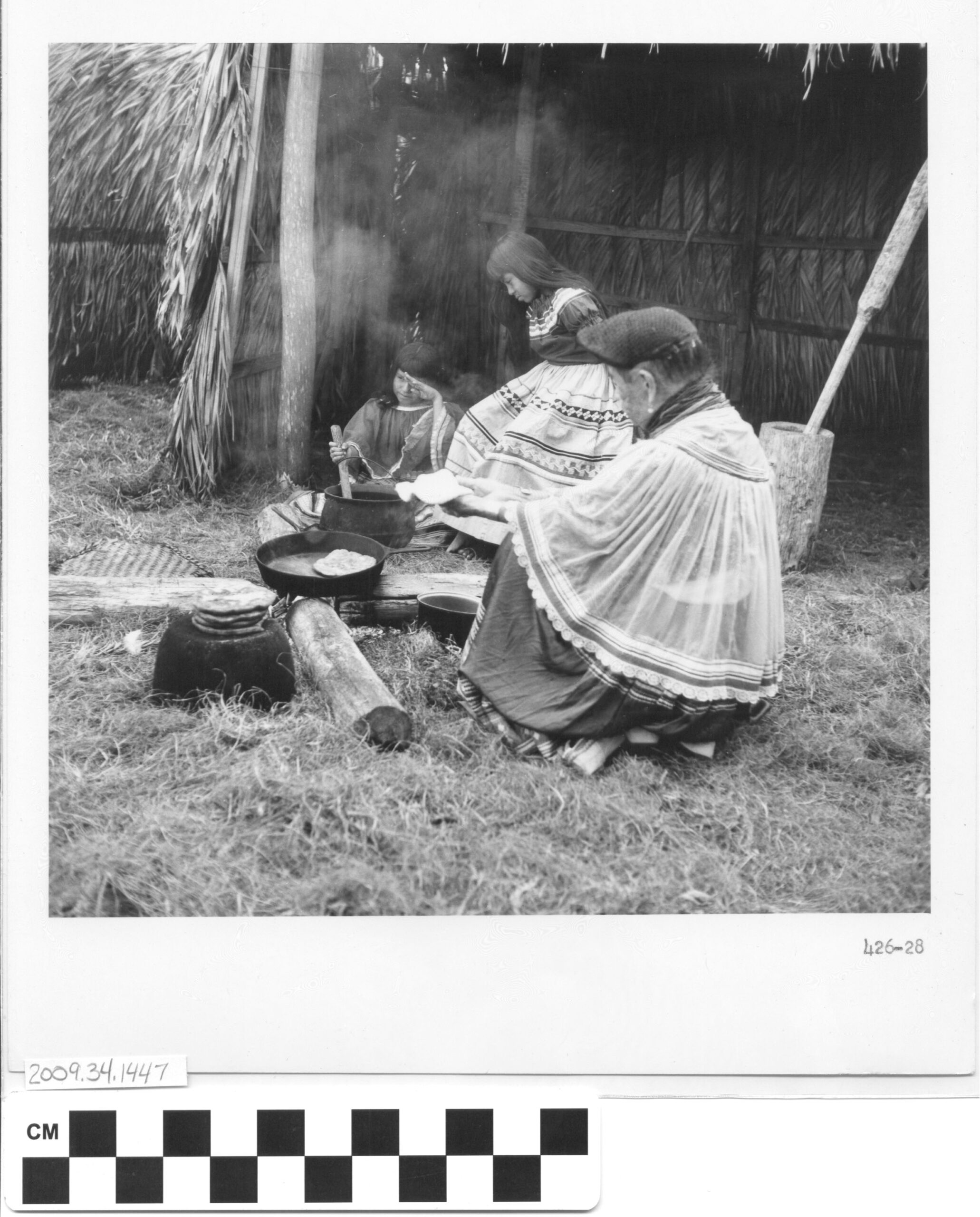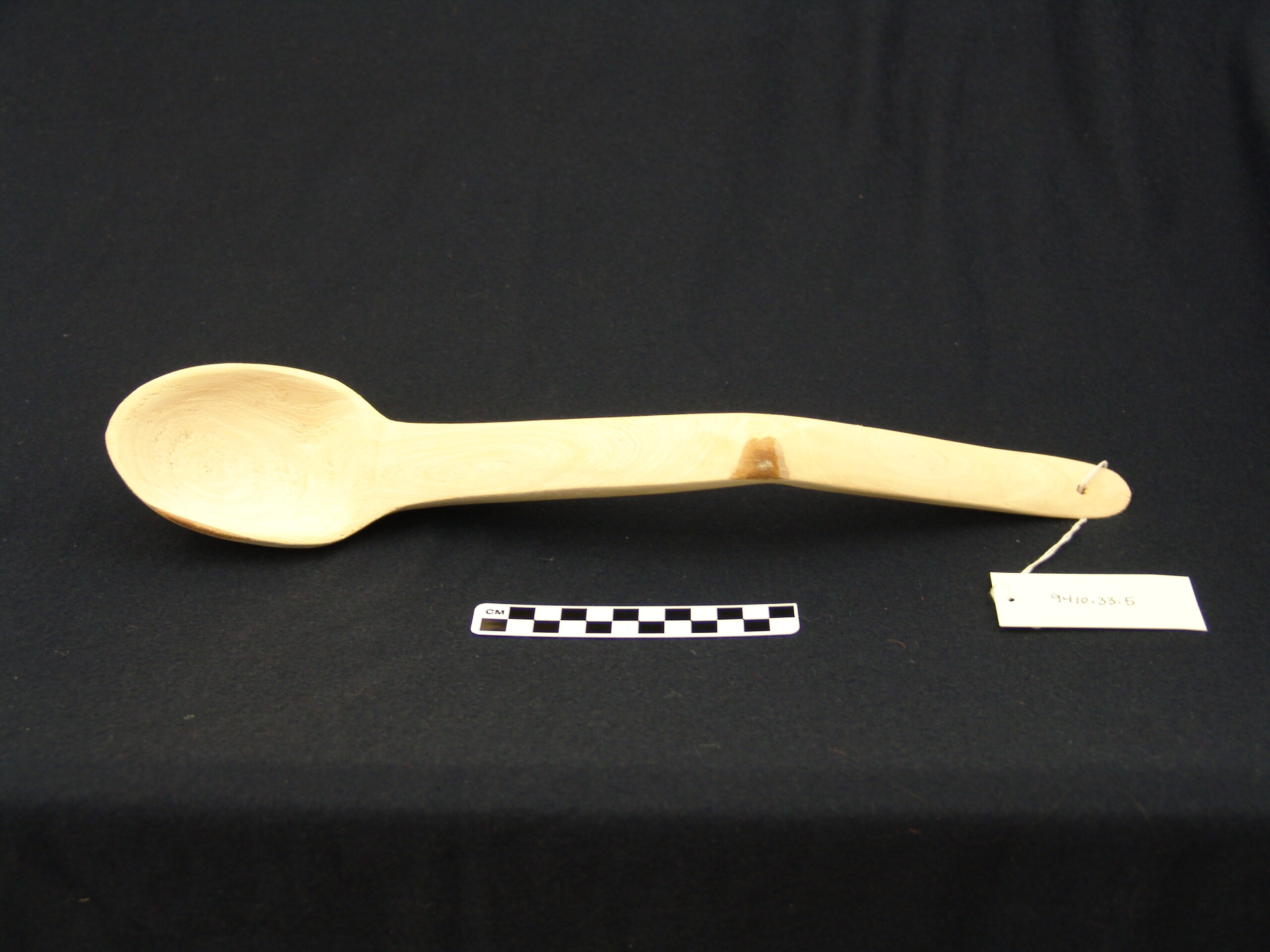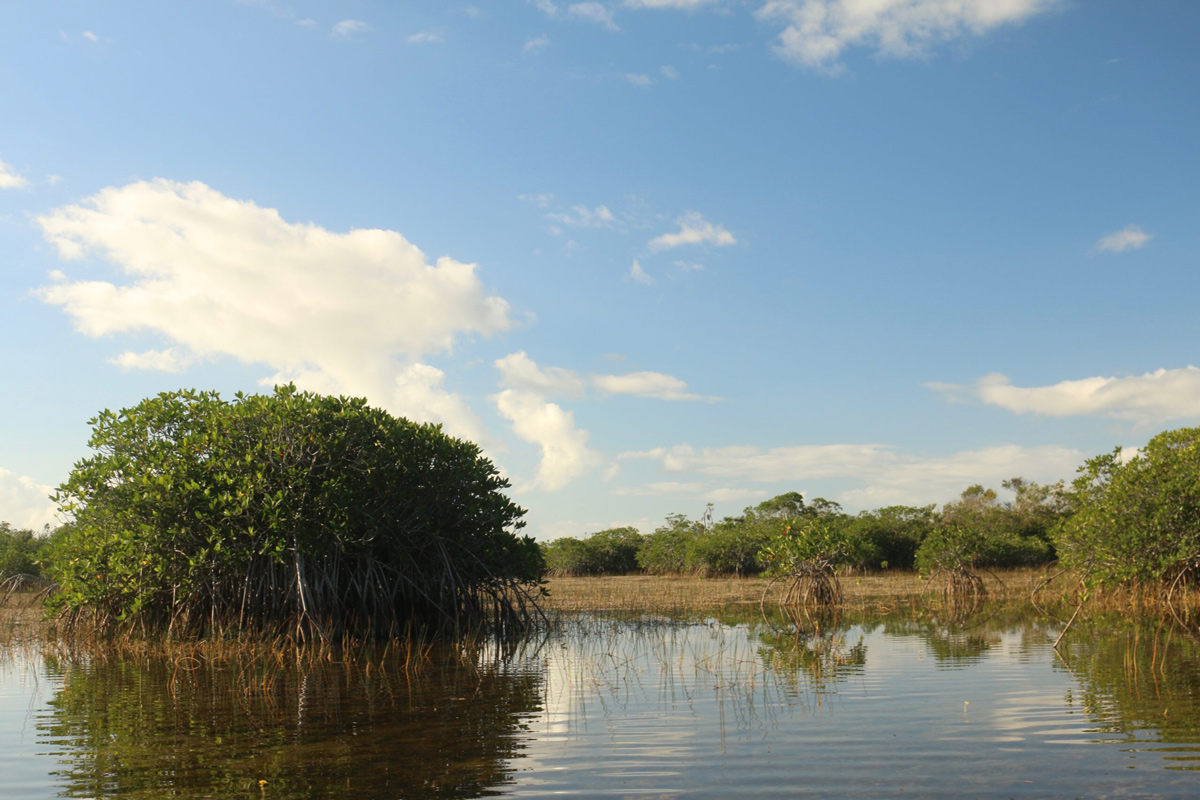Traditional Seminole Foods: Resistance and Resilience
Let’s face it – we all love to eat. But, food means more than just filling our stomachs. Traditional Seminole foods are intricately tied with family and culture. This week, join us as we learn about some traditional Seminole foods and how they can be looked at through the lens of resistance and resilience. Be warned, you may need a snack as you read along!

Frank Willie’s Village Florida Everglades, Grinding Coontie, ATTK Museum Collection Catalog 2013.3.57
While many traditional foods today are primarily cooked for special occasions, the threads weaving food, family, and culture are still very apparent. Historically, multiple generations of family, from grandparents, to children, to siblings, would all gather to share in meal time. Guests are given coffee or sofkee from over the fire as greeting. A cooking chickee, the Miccosukee word for house, would be at the heart of the camp. That chickee would be dedicated only to cooking. The fire was tended and lasted for weeks at a time.
Foraging, gathering, hunting, and gardening are all important steps in Seminole food preparation. The Everglades is a harsh environment, but a vital one to Seminole people and culture. The connection to the land extended to everything they consumed. In times of struggle, such as during the Seminole War period, being resourceful and resilient was the key to taking care of your family. Access to food was tied closely with safety. Decades later, relationships with trading posts would also emerge and add to the available foods. These relationships and accessibility would shift and grow over time, and eventually augment what we know as traditional Seminole foods.
Coontie
Would you eat something that could poison you? You need a vast amount of knowledge and skill to process this root vegetable! Coontie, or the Zamia plant, is a small woody palm-like plant found in the Southeast. It is a shrubby low growing plant with red seed cones and a large tuberous root system. Coontie flour is made from these roots. But, in order to make the flour you need to be careful!
The coontie plant contains cycasin, which is poisonous and can lead to liver failure and death. So, the cycasin needs to be washed away and the coontie processed in order to be edible. Roots would be peeled and washed from dirt. Then, they would be stored between dried palm fronds. Each root would then be grated and rinsed, then pounded into a pulp. The pulp would be rinsed many more times, strained, and dried in order to ensure the cycasin was washed away. The resulting flour could be used to make a number of foods. Flat cakes and even a type of sofkee were all made from coontie flour.
Knowledge of how to process the root was just one of the ways the Seminole people were able to outlast US Soldiers in the Everglades. In order to avoid capture after the Indian Removal Act of 1830, the Seminoles relied on their extensive knowledge of plants, animals, and the landscape. Evading soldiers in the swamp, the unconquered Seminole people never signed a treaty despite facing war, removal, and extermination. Foodstuffs like coontie represent the deep connection to the land that helped them be resilient and unwavering in the face of incredible hardship. To learn more about the Seminole Wars and Seminole resistance, here is a good write up from the Tribal Historic Preservation Office.
Sofkee
If sofkee could be summed up in one word, it’s comfort. Made of corn or rice (or in the past, coontie flour), sofkee is a warm stewed porridge drink. A basic sofkee recipe is found here. A pot of sofkee would have been kept over the fire of the cooking chickee and consumed when needed or given to a guest. Sofkee is quite heavy and can keep you full for a long period of time. A sofkee spoon, like the one shown below from the Ah-Tah-Thi-Ki Museum collection, is used to dole out the porridge. These special spoons are carved from a single piece of wood and are a ladle shape, to serve the sofkee when needed.
Sofkee is popular to this day. It can be made plain, or flavored with pumpkin, fruit, or other spices. Guava sofkee was the first flavor I ever tried, and the sweet-tart mix of guava and porridge is comforting and satisfying.
Gardens
Seminole people historically kept well stocked gardens and grew squashes such as pumpkin, tubers, corn, beans, citrus, and other hardy vegetables. Some of these, like pumpkin, would have been used in making flavored corn sofkee and eventually pumpkin fry bread. Seminole pumpkins are a particularly interesting and versatile squash that thrives in the Florida heat. With a thick shell like skin to trap water, they have a similar taste to a butternut squash. A native squash to Florida, they are grown vertically and have a high yield. Seminole pumpkins are a variety of colors and grow up to 12 lbs.
Land would be cleared in hammocks for gardens where they could be protected and hidden. Due to the landscape of hammocks, you would not be able to see the gardens from the outside. They also would be on slightly higher ground to avoid getting flooded by water. These gardens more than likely wouldn’t look like gardens to an outsider. This also was by design. If someone were to stumble across a garden of edible plants, what better way to protect it than make it not look like a garden?
Hammocks were particularly important during the Seminole War period for hiding gardens and living spaces. Dave Scheidecker, the Senior Research Coordinator for the Seminole Tribe of Florida’s Tribal Historic Preservation Office was kind enough to talk to me about historic use of hammocks for garden plots. Gardens would “always be in a hammock separate from where they lived, up to a mile away” states Scheidecker. “One (hammock) for living, one for the garden.” This meant if “someone finds one, you still have the other.” Hammocks were regularly used for gardens up through the mid 20th century for protective purposes.
Fry Bread

Print, ATTK Museum Collection Catalog 2009.34.1447
Fry bread can be sweet or savory – either option is a pleasure to eat. Different recipes for fry bread are found throughout the United States in indigenous communities. Oil, water, and flour are the main ingredients. Fry bread is simple, versatile, and delicious. From Indian tacos to pumpkin fry bread dusted in powdered sugar, this Seminole food is adaptable. To make plain fry bread, you mix the slightly sticky batter, hand form patties, and fry in very hot oil. Then, you drain the bread of excess oil and eat it fresh. Recipes like this fry bread would be ideal for feeding a large number of family members and guests. Made in bulk, you could feed dozens of people from one batch of batter.
A personal favorite is fresh pumpkin fry bread. A recipe for pumpkin fry bread is here in a Seminole Tribune article from 2012. Rich and sweet, this pumpkin fry bread is similar to a doughnut. Pumpkin fry bread are eaten with powdered sugar sprinkled on top, or plain. In many ways, this is the perfect blend of old and newer traditional Seminole foods. Pumpkin, a traditional crop, melded together with fry bread which came into popularity more after the establishment of Seminole reservations.
In November, the Ah-Tah-Thi-Ki Museum in Big Cypress hosts its American Indian Arts Celebration. A Fry Bread competition has been held in the past, and people compete for the best fry bread recipe. If you are lucky some of the traditional foods we have talked about here may be on the menu! Located on the Museum’s festival grounds, you can come check out arts, crafts, fashion shows, and of course, food. Check here for updates on AIAC 2022.
Gar
Gar, a plentiful fish, inhabit the Everglades which serve as a resource for the Seminole people. They are found in the Southeastern United states, as far north as Georgia. With a distinctive torpedo-shaped body, broad snout, and sharp teeth, these fish are easy to identify on sight. Anglers consider them a nuisance or “trash” fish, but gar are a traditionally harvested fish for the Seminole people. Both garfish and turtles are popular roasted over the fire. Gar are roasted over the fire cleaned and whole, with the skin scored.
When preparing garfish, it takes some special care. Garfish teeth are extremely sharp, as adult garfish eat anything from other fish, shrimp, and crayfish. They also have bony scales that are tough to cut through. The roe from a garfish is toxic when consumed. So, whoever cleans the fish must be careful not to contaminate the meat. Like coontie, preparing garfish can be dangerous!
Taal-holeelke “Swamp Cabbage”
Have you ever seen canned Hearts of Palm in the grocery store? You may have had this food before without even knowing it! The deep heart of the sabal palm, swamp cabbage is a delicate and versatile. Tough outer leaves are stripped off to get to the inner heart. The heart is the most tender part, and a creamy white color. If you would like to know more about how it is prepared, here is a quick recipe. Beyond this simple recipe, it is also stewed with salted pork, cooked with sugar, or even eaten raw.
In a 2009 interview with the Ah-Tah-Thi-Ki Museum’s Oral History Coordinator, Lorene Gopher said “the swamp cabbage, we used to eat that all the time when I was younger because we did not go running into town for groceries or anything like that.” Like much of the Seminole foods we have discussed today, their availability in nature is central to their use. Sabal palm is plentiful in the Everglades, including along the Ah-Tah-Thi-Ki Museum boardwalk.

Sofkee Spoon, Frank J. Billie, ATTK Museum Collection Catalog 1994.28.5
Seminole Food Today
Sofkee, coontie, fry bread, gar, and swamp cabbage are only a few of the traditional Seminole foods. Some, like sofkee, have been made for many, many generations. Others, like fry bread, are newer in the recipe book but just as important. All of them show a relationship between natural Florida and the Seminole people and their culture.
Today, Seminole people enjoy the same luxuries as anyone living in South Florida. Fast food, delivery pizza, and groceries stores are significantly more convenient than foraging for your dinner. But, these traditional Seminole foods are also closely tied with family and culture. Some are tied to periods of resistance or resilience in the face of environmental or government pressures. Today, you see Seminole foods like these at the American Indian Arts Celebration, Seminole Tribal Fair and Pow Wow, Brighton Field Days, and other festivals, events, and gatherings. If you would like to visit and experience Seminole foods for yourself, please subscribe for updates on events through the Ah-Tah-Thi-Ki Museum, try some of the recipes linked above, or stay updated on the future re-opening of the Swamp Water Café on Big Cypress.



Julius Williams
Interesting page I like it.